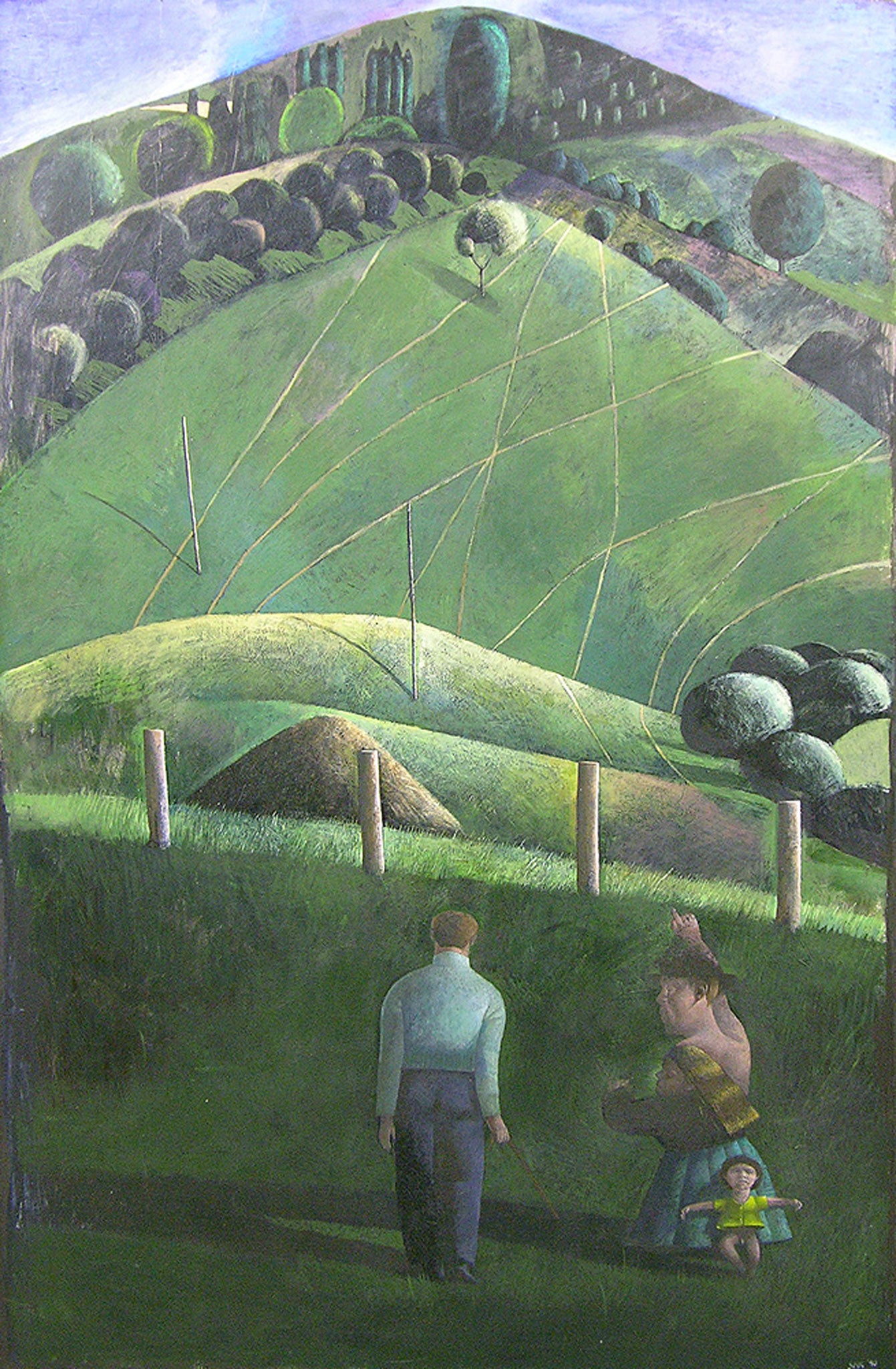Great works: A Member of the Family By Sarah Raphael (1990)
Marlborough Fine Art, London

Some years into her all-too-brief career as an extraordinarily talented painter in oils, in fact the best of her generation, Sarah Raphael turned to story-telling of a pleasingly obtuse and almost folkloric kind. This painting is a landscape of sorts. In fact, it is dominated by the presence of landscape.
And yet it is a landscape which is not being allowed to be itself. It is under intense scrutiny by a small and perhaps mildly truculent party of what could easily be itinerant circus folk – see the size of the head of the pointing man, and that dwarfish woman with the oddly ironed hair who comes on behind, close-pressing, into whom he almost merges.
It is a landscape which is being asked: what kind of landscape is this? And: what can we expect to find here? Speaking of Victorian England makes us immediately aware of the fact that there is someone else whose influence has fed into this work: Samuel Palmer. Look at the shapeliness of that mountain, those globby trees. The slight gaucheness, even naivety, of the rendering of the scene also puts us in mind of Stanley Spencer, and the way his figures relate to the landscape near Cookham.
With Spencer, inevitably as night follows day, come thoughts of religion, but how much of the religious impulse is there here? There is a note of almost Palmerian beatitude, certainly, in the way that the light illuminates slopes here and there, but it is a muffled note for all that. There is a degree of anxiety too. Why is that strange, marionette-like child turned to face us, spread-eagled somewhat like a saviour on a cross? If she is pleading, why? Is it that she does not want to be in the company of those odd others?
But is she less odd than they are? What hope of an answer to her questions can we hope to give her? After all, we are onlookers too. In fact, we and those characters – for they do look like characters got up for an occasion – are all slightly unnerved onlookers. And what is unnerving us is the immensity of that mountain, and how it seems to brood and lean, pregnantly, and somewhat malevolently too. As if it is threatening us by pointing out its largeness when seen in the humbling context of our – and their – smallness.
There is all this light, gently though intermittently diffused, and then there are those scorings or ley lines across the rising field – if that is what they are. The onlookers are walking over lines too, but they more closely resemble tram lines than ley lines. These lines seem to hint at some element of mystery hidden in the landscape, some ill-defined ghosts of pre-history. They are keys to we know not what. The figures are engulfed in the darkness of deep shadow, which ends, all of a sudden, at a row of fence posts or pollarded trees. This is a very tall painting – it feels so – and the figures at the bottom look positively belittled, mesmerised, unnerved by what it is that rises up in front of them.
Beyond those posts, so dutifully aligned as if to mark a very strict line of demarcation, some quick passage from darkness into light, there is a rick – again its shape harks back to Palmer – and at the top of this swelling hillside, a sudden outbreak of blueness, which may be sea or sky. The brush strokes, the way they stipple and turn about themselves, suggest sea. So this is land's end, and it has ended in a great, dramatic flourish.
About the artist
Sarah Raphael (1960-2001)
Sarah Raphael, daughter of the novelist and screenwriter Frederick Raphael, was born at East Bergholt in Suffolk, studied at Camberwell School of Art, and died of septicaemia following pneumonia. She was much afflicted by migraines, and their influence upon her work was the subject of journalism and medical research.
Join our commenting forum
Join thought-provoking conversations, follow other Independent readers and see their replies
Comments